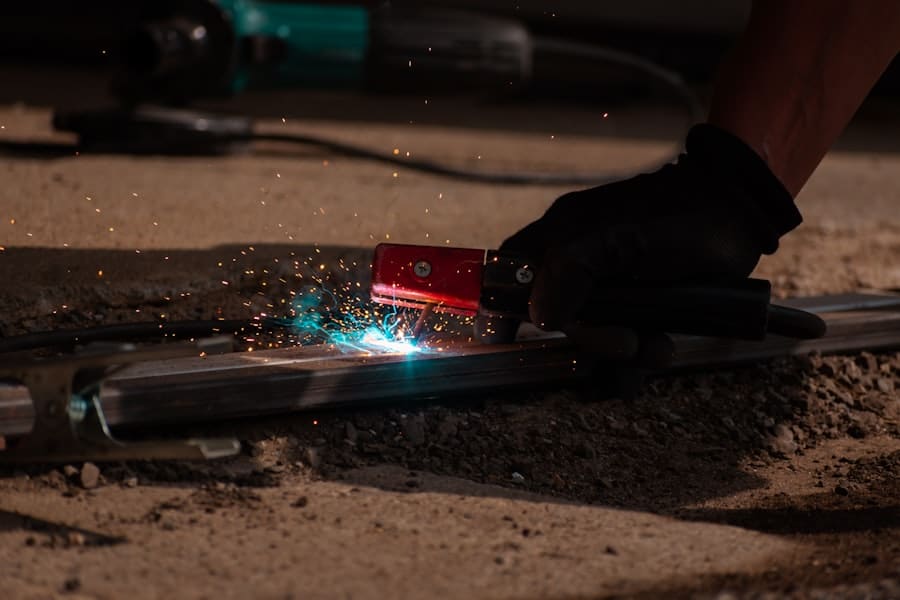Augmented Reality (AR) and Virtual Reality (VR) have emerged as transformative technologies in various sectors, including education and vocational training. These immersive technologies provide learners with interactive experiences that enhance understanding and retention of complex concepts. In vocational training, where practical skills and real-world applications are paramount, AR and VR offer unique opportunities to simulate environments and scenarios that would otherwise be difficult or impossible to replicate in traditional classroom settings.
By integrating these technologies into vocational training programs, educators can create engaging learning experiences that prepare students for the demands of their chosen fields. The rise of AR and VR in vocational training is driven by the need for innovative teaching methods that cater to diverse learning styles. Traditional training methods often rely on lectures and textbook learning, which may not effectively engage all students.
In contrast, AR and VR provide hands-on experiences that allow learners to practice skills in a safe, controlled environment. For instance, a student training to become an electrician can use VR to navigate a virtual building, identifying wiring issues without the risk of electrical hazards. This shift towards experiential learning not only enhances skill acquisition but also fosters confidence among learners as they prepare for real-world challenges.
Key Takeaways
- AR and VR offer immersive and interactive experiences for vocational training, enhancing learning outcomes.
- Advantages of using AR and VR include realistic real-world simulations, hands-on practice, and risk-free learning environments.
- Examples of AR and VR applications in vocational training include virtual equipment training, interactive maintenance simulations, and safety training scenarios.
- AR and VR have a positive impact on learning outcomes in vocational training, leading to improved retention, engagement, and skill acquisition.
- Challenges and limitations of implementing AR and VR in vocational training include high costs, technical requirements, and the need for specialized content development.
Advantages of Using AR and VR for Real-World Simulations
One of the most significant advantages of AR and VR in vocational training is the ability to create realistic simulations that closely mimic real-world scenarios. This capability allows learners to engage in practical exercises that would be logistically challenging or unsafe in a traditional training environment. For example, medical students can practice surgical procedures using VR simulations that replicate the intricacies of human anatomy, enabling them to hone their skills before working with actual patients.
Such immersive experiences can lead to better preparedness and reduced anxiety when facing real-life situations. Moreover, AR and VR facilitate immediate feedback and assessment, which are crucial for effective learning.
This instant feedback loop is particularly beneficial in vocational training, where mastering specific skills is essential. For instance, a trainee mechanic can work on a virtual car engine and receive guidance on their technique, helping them refine their skills before applying them in a workshop setting. This combination of realistic practice and immediate feedback enhances the overall learning experience and contributes to skill mastery.
Examples of AR and VR Applications in Vocational Training
Numerous industries have begun to adopt AR and VR technologies for vocational training, showcasing their versatility and effectiveness. In the field of healthcare, institutions like the University of Illinois College of Medicine have implemented VR simulations for medical students. These simulations allow students to practice complex procedures such as intubation or suturing in a risk-free environment.
By immersing themselves in these virtual scenarios, students can develop their skills without the pressure of real-life consequences. In the construction industry, companies like Skanska have utilized AR to enhance safety training for workers. By overlaying digital information onto physical environments through AR glasses or mobile devices, trainees can visualize potential hazards on construction sites.
This proactive approach not only educates workers about safety protocols but also empowers them to identify risks before they become problematic. Such applications demonstrate how AR can bridge the gap between theoretical knowledge and practical application, ultimately leading to safer work environments.
Impact of AR and VR on Learning Outcomes in Vocational Training
The integration of AR and VR into vocational training has shown promising results in improving learning outcomes. Research indicates that immersive learning experiences can lead to higher retention rates compared to traditional methods. A study conducted by PwC found that employees who underwent VR training were four times more focused than their e-learning counterparts and were 275% more confident in applying what they learned.
This heightened engagement translates into better performance in real-world tasks, as learners are more likely to retain information when they actively participate in their education. Furthermore, AR and VR can cater to various learning styles, accommodating visual, auditory, and kinesthetic learners alike. For instance, visual learners benefit from the immersive graphics of VR simulations, while auditory learners can engage with interactive tutorials embedded within these environments.
Kinesthetic learners thrive on hands-on experiences, which are abundant in both AR and VR applications. By addressing diverse learning preferences, these technologies create a more inclusive educational landscape that enhances overall effectiveness in vocational training.
Challenges and Limitations of Implementing AR and VR in Vocational Training
Despite the numerous advantages of AR and VR in vocational training, several challenges hinder widespread implementation. One significant barrier is the high cost associated with developing and maintaining these technologies. Creating high-quality simulations requires substantial investment in software development, hardware procurement, and ongoing updates.
Many educational institutions may struggle to allocate sufficient resources for such initiatives, particularly in regions with limited funding for vocational programs. Additionally, there is a learning curve associated with adopting AR and VR technologies for both instructors and students. Educators must be trained not only in how to use these tools effectively but also in how to integrate them into existing curricula.
This transition can be daunting for some educators who may be accustomed to traditional teaching methods. Furthermore, students may initially find it challenging to adapt to immersive environments if they lack prior experience with such technologies. Addressing these challenges requires comprehensive training programs and ongoing support for both educators and learners.
Future Trends and Developments in AR and VR for Vocational Training
Democratizing Access to Vocational Training
This democratization of technology allows vocational training programs to reach a broader audience, particularly in underserved communities where resources may be limited. As a result, more people can access high-quality training and develop the skills they need to succeed in their chosen careers.
Personalizing Learning Experiences with AI
Another trend is the integration of artificial intelligence (AI) with AR and VR applications. AI can enhance the personalization of learning experiences by adapting simulations based on individual performance and preferences. For example, an AI-driven VR program could analyze a learner’s progress and adjust the difficulty level of tasks accordingly, ensuring that each student receives a tailored educational experience.
Revolutionizing Vocational Training with Customized Learning Pathways
This fusion of AI with immersive technologies has the potential to revolutionize vocational training by creating highly customized learning pathways that cater to each learner’s unique needs.
Case Studies of Successful Implementation of AR and VR in Vocational Training
Several case studies illustrate the successful implementation of AR and VR technologies in vocational training across various industries. One notable example is Boeing’s use of AR for aircraft assembly training. The company has developed an AR system that overlays digital instructions onto physical components during assembly processes.
This approach has significantly reduced assembly time while improving accuracy, demonstrating how AR can enhance efficiency in complex manufacturing environments. In another instance, Walmart has embraced VR for employee training across its retail operations. The retail giant utilizes VR simulations to prepare employees for various scenarios they may encounter on the job, such as handling customer service issues or managing inventory challenges during peak shopping seasons.
By immersing employees in realistic situations, Walmart has reported improved employee confidence and performance levels, showcasing the effectiveness of VR in enhancing workforce readiness.
Recommendations for Integrating AR and VR into Vocational Training Programs
To effectively integrate AR and VR into vocational training programs, several recommendations should be considered. First, institutions should conduct thorough needs assessments to identify specific skills gaps within their curricula that could benefit from immersive technologies. By aligning AR and VR applications with industry demands, educators can ensure that their programs remain relevant and effective.
Second, collaboration with industry partners is essential for developing high-quality content that reflects real-world practices. Engaging with professionals who possess firsthand experience in their respective fields can provide valuable insights into creating realistic simulations that accurately depict workplace scenarios. Finally, ongoing professional development for educators is crucial to ensure they are equipped with the necessary skills to implement these technologies effectively.
Providing training sessions focused on both technical proficiency and pedagogical strategies will empower instructors to leverage AR and VR tools to enhance student learning outcomes. By following these recommendations, vocational training programs can harness the full potential of AR and VR technologies, ultimately preparing students for success in their chosen careers while fostering a culture of innovation within educational institutions.
A related article discussing the best software for small businesses in 2023 can be found here. This article provides valuable insights into the latest software options that can help small businesses streamline their operations and improve efficiency. By incorporating cutting-edge technology like AR and VR into their training programs, small businesses can stay ahead of the curve and ensure their employees are well-equipped for success in the modern workplace.
FAQs
What is AR and VR?
AR stands for Augmented Reality, which is a technology that overlays digital information onto the real world through a device such as a smartphone or AR glasses. VR stands for Virtual Reality, which is a technology that immerses users in a completely virtual environment through a headset or goggles.
How are AR and VR being used in vocational training?
AR and VR are being used in vocational training to create realistic simulations of real-world scenarios. This allows trainees to practice and develop their skills in a safe and controlled environment before applying them in the real world.
What are the benefits of using AR and VR in vocational training?
Some benefits of using AR and VR in vocational training include increased engagement and retention, the ability to practice complex tasks without risk, and the opportunity to provide training in remote or hard-to-access locations.
What are some examples of vocational training programs using AR and VR?
Examples of vocational training programs using AR and VR include simulations for medical procedures, automotive repair, construction, and manufacturing. These simulations allow trainees to practice hands-on skills in a realistic and immersive environment.
Are there any limitations to using AR and VR in vocational training?
Some limitations of using AR and VR in vocational training include the cost of equipment and development, the need for technical support and maintenance, and the potential for simulation sickness in some users. Additionally, not all vocational skills may be effectively taught through AR and VR simulations.



